5 Simple Ways to Combat Fatigue and Get Your Energy Back
Fatigue is something that plagues so many of us…
Whether you wake up feeling drained, struggle with the mid-afternoon burnout, fall asleep on the sofa at 8pm or have that all-day-exhaustion – it’s something that’s a huge issue, and I am determined to get you out of that fatigue cycle.
The more energy you have, the easier life gets…
With abundant energy it’s easier to go exercise, it’s easier to get up early and get stuff done, it’s easier to find the time to eat healthy, it’s easier to stick to your plan and reach goals…
But when you’re fatigued, everything is harder…
And it’s harder to get out of that fatigue…
It’s harder to make the changes you need to make to get out of the energy slump…to get up and exercise, to get up early to prepare a healthy breakfast, to go shopping for healthy foods and prepare something nourishing when your body is screaming for carbs and ‘comfort’ foods…
I believe that having energy is the #1, most important goal we should be aiming for.
Why?
Because when you have energy you radiate positivity and action and all of your other goals become exponentially easier and more achievable.
In fact, that is MY number 1 goal for you with this whole site – to get you energized!
And in this guide we’re taking some big steps forward…
Remember – making a HUGE step forward with your energy can often come down to just ONE THING…
In my experience, for most people, there is usually just ONE THING that’s holding them back from getting the energy they deserve, and ending fatigue.
So let’s get into it…
Five Simple Ways to Stop Fatigue and Get Your Energy Back
1. Go Grain Free
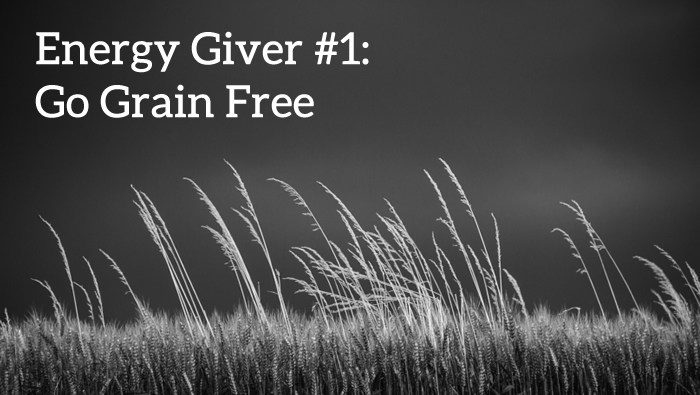
For so many decades we’ve been told grains are a health food, and that multi-grain is the best, most healthy choice.
We’ve been fed a lie.
On so many levels grains (wheat, in particular) are causing more health issues than practically any other food. Not only are they terrible for us, but because we’re told they are GOOD for us, we tend to eat them a LOT…
Here are just seven of the many reasons why you have to get the grains out of your diet if you want to get rid of fatigue:
- Grains are Highly Inflammatory: Inflammation is at the root cause of so many fatigue-based conditions (chronic fatigue, Fibromyalgia and more) and grains are one of the most inflammatory foods we can eat. And as you see as you go through these reasons below – each of these negatives of eating grains has a knock on effect to the others too – it’s like a vicious cycle.
- Grains Cause a Bigger Blood Sugar Spike than Chocolate:Wheat and grains spike blood sugar like nothing else – more than eating a chocolate bar, drinking a soda, eating a cake or sneaking a cookie.In fact, this is the famous question that Dr David Perlmutter (neurologist, functional medical practitioner and NYT Bestselling author of “Grain Brain”) asks at the beginning of his presentations.
Which of those spikes blood sugar more: an apple, a candy bar or a slice of wholegrain bread?
According to Dr Perlmutter, people always say the chocolate or candy, followed by the fruit and almost nobody says the bread. But the bread does the most damage (and multi/wholegrain is as bad as white bread).
Why?
Wheat contains a complex carbohydrate called amylopectin A – and this carb drives your blood sugar very high, very, very quickly.
Remember, if you’re on anything like a standard Western diet, 70% of your food consumption either is grain based – and therefore you’re consuming a LOT of amylopectin A.
When there is high blood sugar, insulin is released by the pancreas, and the higher the blood sugar the more insulin must be released.
And if you trigger high blood sugars repeatedly, the accompanying overproduction of insulin will lead to huge and rapid production of visceral fat accumulating around your abdomen (this has it’s own, related fatigue effect which we will get onto in a few mintues).
And the bigger your belly (i.e. the more visceral fat), the poorer your response to insulin, and the result is that higher and higher insulin levels are demanded, creating a vicious cycle.
Remember, nothing provokes high blood sugar like wheat.
- Damaging to the digestive system:This is when things start to get really bad. When visceral fat accumulates, the flood of inflammatory signals it produces causes the body to respond much less effectively to insulin.This so-called insulin resistance means that the pancreas must produce even more insulin to metabolise the high blood sugar.
Eventually a vicious circle of high blood sugar, increased insulin resistance, increased insulin production, increased visceral fat, leading to more increased insulin resistance, more visceral fat, more insulin production…and so on…leaving you fat, sick and chronically fatigued.
These grains also contain lectins, which are are proteins that simply cannot be digested.
They pass through the wall of our gut undigested damaging the gut, causing inflammation and over-stimulating our immune system to the point where damage occurs, the immune system is imbalanced and fatigue sets in.
When you eat a lot of grains, you get a blocked and compromised digestive system. The lectins in modern grains (especially wheat, but also rye, spelt etc) cause huge inflammation and clogging in the large intestine. This matters, because the large intestine is the organ that extracts nutrients from the food we eat.
When it gets inflamed and clogged by foods such as grains, the walls of the digestive tract are damaged beyond belief, or worse, get covered with undigested matter. The result of either is that the digestive system cannot do it’s job – and so you digest none of the nutrients you consume.
The immediate symptom you’ll notice is fatigue, all day, day in day out – no matter what you eat.
- Suppresses the immune system and prevents nutrient absorption:When you consume grains and they reach your intestines, the gluten in the grains is broken down into it’s two proteins, gliadin and glutenin by an enzyme called transglutaminase (tTG).As these proteins make their way through your digestive system your gut identifies gliadin as a dangerous substance and produces antibodies to attack it.
Now, your body absorbs nutrients from foods to provide you with energy through tiny finger-like growths in the intestines called microvilli.
And these antibodies produced by the tTG destroy and erode these microvilli, meaning that a tiny proportion of the nutrients you’re consuming are being absorbed.
And with no nutrient absorbtion you get the root cause of chronic fatigue. Day after day.
You could be eating super-healthy, but because your digestive system is not able to extract any of the goodness and nourishment from the food – you’ll be lacking nutrients and therefore will have extremely low energy.
- Lead to Leaky Gut: In very little time and after repeated exposure to grains, this leads to Leaky Gut, where holes appear in the intestines allowing toxins to pass through the intestine into the body.Not good.
The immediate effect of this is worsening fatigue to a chronic level. This is where you experience long-term, debilitating fatigue, like when you wake up tired each day. Are sluggish from the moment you reach your desk at 9am. Feel like you need to sleep after lunch. Fall asleep on the couch each night.
Sound familiar?
The next step is that the immune system reacts ferociously to each of these larger particles that can pass through the ‘leaky gut’.
When these larger particles are allowed out of the intestine, the body reacts to each like a foreign invader – attacking it and creating harmful cytokines and antibodies to each one.
This hyperstimulation of the immune system, not only leaves you with even MORE fatigue, but quickly leads to the development of auto-immune issues like rheumatoid arthritis (RA), type 1 diabetes, Graves’ disease, and multiple sclerosis.
- Are ‘Anti-Nutrients’:To make this worse, grains also contain the ANTINUTRIENTS phytic acid and lectins. Phylates are mineral blockers that prevents absorption of calcium, magnesium, iron, copper and zinc.And lectins?
They’re the ones we talked about earlier that overstimulate the immune system, provoke inflammation and prevent the digetive system from being able to absorb the nutrients you DO consume.
- Lead directly to brain degeneration:When exposed to pepsin (a stomach enzyme) and hydrochloric acid (stomach acid produced to digest wheat), gluten is degraded to a mix of polypeptides.These polypeptides are able to cross the blood-brain barrier, that separates the bloodstream from the brain.
This barrier is there for a reason. The brain is highly sensitive to the wide variety of substances that gain entry to the blood, some of which can provoke undesirable effects should they cross into your amygdala, hippocampus, cerebral cortex or other brain structure.
Once having gained entry into the brain, wheat polypeptides bind to the brains morphene receptor, the very same receptor that opiate drugs bind to.
These polypeptides have been labelled ‘exorphins’ – short for exogenous morphene like compounds and this is what creates the mini-high followed by the mood and energy slump right after.
Repeaded exposure to these exomorphins (the dominant of which has been named gluteomorphin) leads to serious imbalance in the brain and has been proven to lead to a far higher likelihood of depression and schizophrenia.
At the very minimum it immediately creates foggy thinking, daytime fatigue and physical sluggishness.
WHOA, I Get It…But What Are These Grains We’re Talking About?
The grains we’re talking about here are wheat, spelt, rye, kamut, semolina, bulgur, barley and so on.
And of course, gluten is largely the big issue here. And gluten is pretty much everywhere in modern convenience foods as a filler, texture provider and additive in so many man-made, processed foods in our supermarkets.
The way to get away from gluten and grains is to go back to eating as naturally as possible. This eliminates grains from your diet almost entirely, because you’re back in control.
And instead of eating grains you can go for things like:
- Quinoa
- Buckwheat
- Brown Rice
- Amaranth
- Gluten-free pastas (go for those with the fewest possible ingredients and see my footnote below)
- Sprouted breads
- Use buckwheat flour instead of wheat flour
I know many of you won’t have heard amaranth of or relate to a vision where you’re eating amaranth and buckwheat every day – but cutting out the gluten, 80-90% of the time is really just down to cutting out bread, pasta and swapping in quinoa, brown rice and sprouted breads instead.
JUST THIS will make a huge difference to your energy, health, weight (if you’re over or under), skin and so much more.
Just cutting out the grains will go a really, really long way.
Important: while this will cut the flow of grains and their gluten, anti-nutrient, inflammatory, amylopectin-A, immune suppressing attack on your body – the only real way to undo a lifetime of grain consumption for most people is to undertake an alkaline cleanse – and I’ll have more on that in the coming weeks.
2. Hydrate PROPERLY
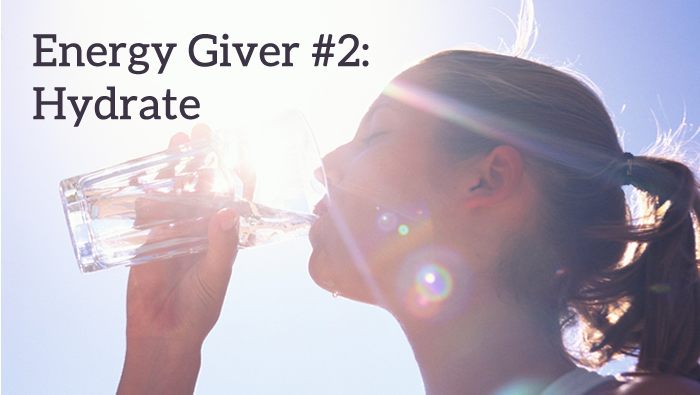
This is a really simple one but so few people are properly hydrated on a daily basis.
In fact, I’d go as far as to say that the vast majority of people are chronically dehydrated on a daily basis.
They say “drink 8 glasses of water per day”. But unless those glasses are 500ml / 16fl oz big then that’s nowhere near enough – and most people don’t even drink those 8 small ones!
Being properly hydrated is a great way to stay alert, mentally focused and energised.
It won’t undo the damage of the above (grains) or the below points, but it will keep you at your potential for where you are with your body right now.
Remember:
“A 5% drop in body fluids will cause a 25-30% loss of energy in most people”
You simply have to remember to get enough quality water each day.
In my Definitive Guide to Alkaline WaterI explain all of the different ways to filter your water to make it alkaline, clean and perfect for your body.
I also give you my step-by-step guide to remembering to get enough each day – making it foolproof for you!
So I highly recommend you check that out now by clicking here.
3. Quit Sugar
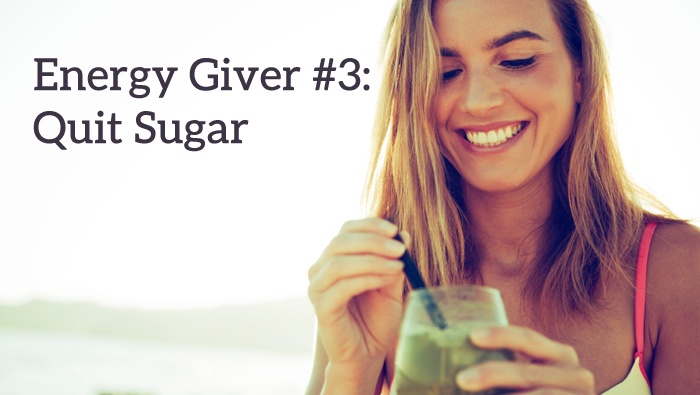
Sugar is at the root-cause of pretty much every health battle, every condition, every ache, pain and waistline.
Proven to be more addictive than cocaine, it is a craving that some people never kick their whole life.
And as time goes on and society ‘develops’ and food manufacturers get better and better at making us addicted to their foods we are consuming more and more sugar.
We know it is bad for us (even if not everyone knows quite how much), and yet we succumb to it every day.
I have a full guide on How to Quit Sugar in 10 Steps here.
But for now I just want to give you the top four steps that I took to quit the sugar habit:
1. Get Rid of Liquid Sugars
Any form of liquid sugar is worse than solid food sugar.
Why?
Sugar without the fibre and bulk is far more detrimental to the body, hits harder and more directly on your liver and it turns of the fat storing process in your liver, leading directly to fat gain.
When you drink sugars (including fructose, in fact, fructose is absolutely the very worst type of sugar you can consume, especially when you drink it) without the fibre, your brain is not sent the message that the calories have been consumed.
Your body literally does not register those calories. As a result of this you stay hungry and crave more sugar.
This includes sodas, juices (ANY juice containing ANY fruit), alcohol, sports drinks, sweetened tea and coffee etc.
This is why I am so adamant about having NO fruit in my green juices or smoothies.
When you consume liquid sugars (and more on fructose below) you don’t feel full, so you eat more all day and you crave more sugar and carbs.
I could spend all day talking about the dangers of consuming soda, but that’s for another day.
Put simply – you have to cut soda and liquid sugars (and sweeteners) from your life if you ever want to get to your true health potential.
2. Have Healthy Snacks Available
I have a full series on healthy snacks coming up, with loads of recipes, ideas and the like…but for now…
Having blood-sugar dips and spikes, sudden huger, feeling tired, irritable and famished – these are all symptoms of sugar addiction and all lead to high sugar intake.
While you’re working on the sugar habit, a key ally is having healthy snacks available.
When you have healthy snacks within reach, 24/7, your chances of beating the sugar addiction go up massively.
Just think about the last 5 snacks you bought from the shops when you were running on empty.
Shop bought snacks are almost ALWAYS filled with sugar.
And as you’ll see below, you don’t necessarily want to over-consume fruit either.
So, here is my guide from a couple of years ago on the Ultimate List of Alkaline Snacks (plus recipes)
And here are a few more recipes I’ve posted just lately too:
Quick Delicious Kale Chips
Cauliflower ‘Buffalo Wings’!
Alkaline Wrapless Wraps
Coconut Chia Cream Pot
3. Have a Big (Grain Free) Breakfast
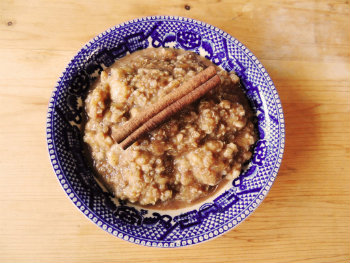 And on the subject of the blood sugar spiral…
And on the subject of the blood sugar spiral…
One of the reasons why most people struggle with sugar cravings throughout the day (think mid-morning, mid afternoon…after big meals…etc) is because they start the day wrong!
Not having a solid breakfast instantly puts you in a blood sugar catastrophe!
Sugar cravings are way more in control and easy to avoid if you don’t let your blood sugar spike and then dip too low.
Having a breakfast containing fats and protein is a great idea.
Here are some ideas:
Alkaline Antioxidant Smoothie
Scrambled Tofu Mega Brekkie
Almost-Alkaline Quinoa & Apple Breakfast Warmer
Alkalizing Baked-Bean Salsa Brekkie
Chai Infused Quinoa Breakfast Porridge
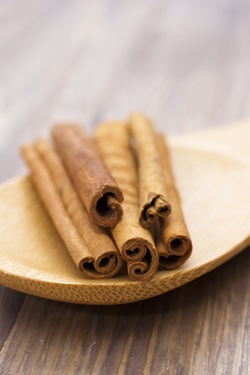 And with breakfasts, I also recommend (especially if you’re creating your own health and alkaline ‘cereals’ or having breakfasts like quinoa or organic oats) — using cinnamon to sweeten your foods.
And with breakfasts, I also recommend (especially if you’re creating your own health and alkaline ‘cereals’ or having breakfasts like quinoa or organic oats) — using cinnamon to sweeten your foods.
In fact, even if you’re just having a nice glass of almond milk this one is a winner.
Numerous show that cinnamon regulates blood sugar, meaning it’s perfect for maintaining stable energy levels and moods.
PLUS it’s alkaline, anti-viral, fantastic for colon health, helps prevent blood clotting and is great for controlling cholesterol.
Whenever you’d think of needing a sweetener of some sort, try cinnamon instead!
4. Get More Magnesium

We’ve covered how inflammation is at the root cause of fatigue for most people, and magnesium is a nutrient that not only actively decreases inflammation – but it also is a nutrient that most people are deficient in.
For a lot of people with CFS, magnesium is the first supplement they are put on.
Of course it’s no surprise that magnesium is one of the very-most alkaline minerals there is.
So when you’re looking for food sources of magnesium you’ll therefore not be surprised to see that the most magnesium-rich foods are also the most alkaline foods.
And of course, with the grain consumption the phyla’s in the gluten are also depleting your body of this critical nutrient!
Here are some of the best food sources of magnesium for you to get started:
Pumpkin Seeds – A quarter-cup of pumpkin seeds has about half the daily amount of recommended magnesium. Pumpkin seeds are the ultimate choice for quick, healthy snacks throughout the day. It helps to keep your energy up and your hunger down plus gives a generous amount of omegas. They’re also a very good source for zinc which works as a mood booster, sleep aid, and sensory enhancer.
Spinach – Dark, leafy, green vegetables are packed with vitamins and minerals. Eating more raw spinach, kale and even broccoli is a great way to get a magnesium boost in your body plus it’s great for your eyes and skin. But it gets even better, just of cup of cooked Spinach gives you three times more nutrients than when eaten raw, simply because the human body isn’t fully capable of digesting all the components in raw spinach.
Swiss chard (silverbeet) – Another leafy, green vegetable to consider is silverbeet, also known as strawberry spinach and Roman kale which is a power food filled with all the goodness your body needs. Just one cup of silverbeet packs 150mg of magnesium, plus it’s a great source for Vitamin K, C and A, iron, fibre and potassium.
Quinoa – Quinoa is very rich in protein, making it quite a filling meal rather than just a plain snack, so it’s an awesome energy enhancer with all nine key amino acids. It also has a higher percentage of fiber than most grains along with iron and lysine which is used for tissue repair and growth.
Black Beans – This is a very common meat substitute for vegetarians because of its high levels of protein, not to mention they’re cheap and easy to prepare. Black beans are good antioxidants and scientists have shown that eating this fiber packed food reduces the risk of some cancers.
Sunflower Seeds – Available all throughout the year, these seeds also help fight cancer because it contains a dietary mineral called selenium. It also helps to reduce stress by soothing the nerves and migraines. Sunflower seeds also keep skin looking youthful and prevent harmful cholesterol from sticking to artery walls.
Avocados – This list already sounds like someone’s lunch so why not throw in some avocados. They’re great for keeping your heart healthy and tackling diseases in the body making them one of the most nutritious fruits you can find in the market. It’s great for sandwiches, spreads, dips and salads. Avocados will easily give around 15 percent of the daily amount of magnesium needed in your diet.
And when it comes to supplementation, there are actually two ways that I recommend you trying: oral AND transdermal.
In simple terms, that’s taking a magnesium capsule and/or trying liquid magnesium applied to the body.
People I know who have a lot of restless leg syndrome find the liquid magnesium (magnesium chloride oil) is much faster working and possibly more effective for them than taking a magnesium capsule.
But that could be a little subjective!
And when it comes to the supplement version, I recommend Magnesium glycinate. I have read many reports about it being the most bioavailable form of magnesium, but personally I’ve also seen and felt the best results (as have my restless leg friends) when they use this – especially over the magnesium citrate – which is the most common form used in cheaper supplements.
5. Cut Out Toxins
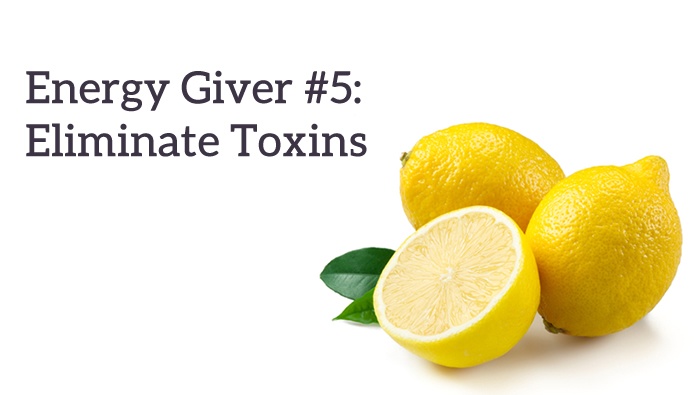
We are surrounded by toxins, and many of these, over time, can impact our body significantly, cause inflammation, hormonal imbalance, and send our energy levels plummeting.
There are currently more than 4 million chemicals categorised by the Environmental Protection Agency, with more than 60,000 of these being produced commercially.
Three new toxic compounds are introduced each day.
It’s frightening stuff.
Back in 1992, the EPA published the results of a study where they took 7,000 random Americans and tested their urine for toxic chemicals.
The results?
I bet you’d never guess…but have a go. How many of them do you think had toxins in their urine?
Of those 7,000 tested, chemicals like pentachlorophenol, a wood preservative, and others were found in 71% of them.
It’s shocking but probably not surprising.
And these were not workers at a chemical plant, or even builders, plumbers or anyone else who regularly comes into contact with chemicals.
The sample for the study was a completely random set of average people, you and me.
Many doctors who work with chronically fatigued patients agree that chemical exposure is a major contributor to fatigue and low vitality.
Of course, there are some toxins you can’t control your exposure to.
But so many of these are toxins found in everyday products, in our home and offices.
For example, look at the symptoms of exposure to trichloroethylene (found in floor polish, copy machines, carpet cleaner, etc.). They include fatigue, poor concentration, and drowsiness, among others.
And exposure to toluene, the most common indoor air pollutant, triggers symptoms of fatigue, poor concentration, drowsiness, and headache.
Methylene chloride is found in hair sprays, antiperspirants, air fresheners, and spray paintpaint thinner, hair spray, adhesives, solvents, paint, flame retardants, and many other common products.
Once inhaled, methylene chloride goes directly to the brain, fat cells, and liver. Common symptoms include fatigue, lethargy, headaches, and chest pain.
It’s important to note that with these toxins, it is the repeated, cumulative exposure that causes the biggest damage. Infrequent exposure or one-off exposure is unlikely to cause too many issues.
But when you look at when and where a lot of these toxins are hiding, they have all the hallmarks of something that we would be repeatedly exposed to over a lifetime!
Air fresheners, shampoos, soaps, laundry liquids, floor cleaners, surface cleaners, toothpastes, makeup, makeup remover, sunscreens, deodorants and so many more everyday items all contain these toxins.
The simple truth of this is, it’s easy to get whipped up in a frenzy and freak out – but you just have to start taking the steps to remove these toxins from your life as best as you possibly can.
The following steps are really easy to take and a great way to get started:
- Swap for all-natural cleaning products
- Go for natural, chemical-free and preferably organic shampoos and conditioners
- Use baking soda toothpaste
- Use mineral-based deodorant
- Use chemical-free laundry detergents
- Stop using unnecessary chemicals such as fabric softeners, leave-in oven cleaners (the worst), unrequired skin moisturisers, mouthwash (unless you have a natural one) – and start thinking more consciously about what you put on and in your body
I also recommend you check out the unbelievably excellent EWG’s Cleaners Hall of Shame, where they list out products that claim to be green, but aren’t, products that have been banned in other countries, cleaners that can burn and blind, cleaners that emit toxic fumes and more.
Again: while cutting the toxins out will start to turn your energy and vitality around, a cleanse is necessary for most people to undo the years of damage caused by a lifetime of toxin exposure. I’ll have more on cleansing your body in the coming weeks.
Getting More Energy Can Be As Simple As Changing ONE THING…
Fatigue can be a vicious cycle. The more tired you are the harder it is to make the changes that you need to make to get more energy.
But, breaking that cycle can be a lot more simple than most people think. In fact, quite often it can be just ONE THING that separates you from the fatigue you have now to the energy you’ve always wanted.
Try the above steps, starting with #1 – going grain free, and see the difference this can make.
Ross
—
Scientific References & Research [Article: Get Your Energy Back]
Added Sugar Intake and Cardiovascular Diseases Mortality Among US Adults ; Yang Q, Zhang Z, Gregg EW, et al. JAMA Internal Medicine. Published online Febraury 3 2014 (Link to research) Opposing effects of fructokinase C and A isoforms on fructose-induced metabolic syndrome in mice.; Takuji Ishimoto, Miguel A. Lanaspa, MyPhuong T. Le, et al; Proceedings of the National Academy of Sciences, February 27, 2012; (Link to research) Greater Fructose Consumption Is Associated with Cardiometabolic Risk Markers and Visceral Adiposity in Adolescents; N. K. Pollock, V. Bundy, W. Kanto, C. L. Davis, P. J. Bernard, H. Zhu, B. Gutin, Y. Dong; Journal of Nutrition, 2011; 142 (2): 251 (Link to research) The internal circadian clock increases hunger and appetite in the evening independent of food intake and other behaviors; Frank A.J.L. Scheer, Christopher J. Morris and Steven A. Shea; Obesity Journal; Volume 21, Issue 3, pages 421–423, March 2013; (Link to research) Effect of ground cinnamon on postprandial blood glucose concentration in normal-weight and obese adults; Magistrelli A, Chezem JC.; Academy of Nutrition and Dietetics; 2012 Nov;112(11):1806-9.; (Link to research) Effect of cocaine and sucrose withdrawal period on extinction behavior, cue-induced reinstatement, and protein levels of the dopamine transporter and tyrosine hydroxylase in limbic and cortical areas in rats; Grimm, J.W., et al.; Behavioral Pharmacology 2002 Sep 13(5-6):379-88; (Link to research) Anti-inflammatory and arthritic effects of thiacremonone, a novel sulfurcompound isolated from garlic via inhibition of NF-kB. Ban JO, Oh JH, Kim TM et al. Arthritis Res Ther. 2009; 11(5): R145. Epub 2009 Sep 30. 2009. Omega-3 Fatty acids infusions as adjuvant therapy in rheumatoid arthritis. Bahadori B, Uitz E, Thonhofer R, et al.JPEN J Parenter Enteral Nutr. 2010; 34(2):151-5. Nutrition and health during mid-life: searching for solutions and meeting challenges for the aging population.Chedraui, P., & Perez-Lopez, F. R. (2013). Climacteric, 16(S1), 85-95. Stability of betalain pigments from a red beetroot (Beta vulgaris). Elbandy MA and Abdelfadeil MG. Poster Session Presentation. The First International Conference of Food Industries and Biotechnology & Associated Fair. Al-Baath University, North Sinai, Egypt. A functional genomic perspective on human well-being. Fredrickson, B. L., Grewen, K. M., Coffey, K. A., Algoe, S. B., Firestine, A. M., Arevalo, J. M. G., et al. (2013). Proceedings of the National Academy of Sciences, 110(33), 13684-13689. Gingerol inhibits nitric oxide synthesis in activated J774.1 mouse macrophages and prevents peroxynitrite-induced oxidation and nitration reactions. Ippoushi K, Azuma K, Ito H, Horie H, Higashio H. [6]- Life Sci. 2003 Nov 14;73(26):3427-37. Neuroprotective Herbs and Foods from Different Traditional Medicines and Diets. Iriti, M., Vitalini, S., Fico, G., & Faoro, F. (2010). Molecules, 15(5), 3517-3555. Interacting Inflammatory and Growth Factor Signals Underlie the Obesity-Cancer Link. Lashinger, L. M., Ford, N. A., & Hursting, S. D. (2014). The Journal of Nutrition, 144(2), 109-113. The role of inflammatory mediators in the biology of major depression: central nervous system cytokines modulate the biological substrate of depressive symptoms, regulate stress-responsive systems, and contribute to neurotoxicity and neuroprotection. Licinio, J., & Wong, M. L. (1999). Mol Psychiatry, 4(4), 317-327. – Omega-3 fatty acids (fish oil) as an anti-inflammatory: an alternative to nonsteroidal anti-inflammatory drugs for discogenic pain. Maroon JC, Bost JW. (2006) Surg Neurol. 2006 Apr;65(4):326-31.





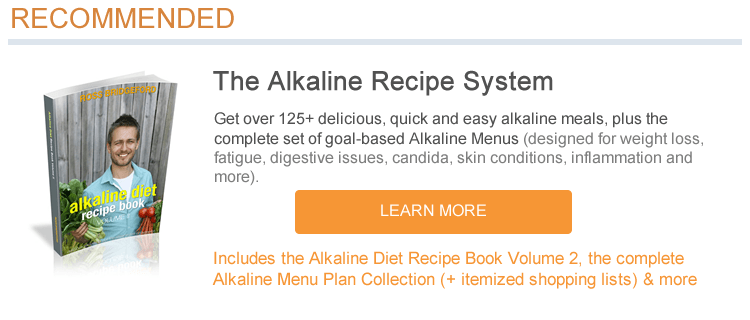

Hi Ross,
Thanks for all that you do, genuinely grateful. I’ve followed you on and off for years.
I notice you’re not answering all queries, but hopefully you have a response to this.
I see you talk a fair amount about gut health, however some of the great foods you recommend, Dr Steven Grundy says should not be consumed for gut health. The main ones that stand out are
Chia Seeds
Pumpkin Seeds
Sunflower Seeds
Almonds that still have skin on (Peeled almonds are okay but the skins contain lectins)
Tomatoe (Skin and seeds)
I believe all of the above contain lectins which is why Grundy has them on his NO THANK YOU list.
What is your take on this? In the past I’ve relied on pumkin seeds for thei nutrient content, I also used to eat a lot of almonds and cashews – it’s hard finding almonds without the skin and ridiculously time-consuming to skin them. I’ve sadly given up my beloved cashews and found an alternative for dairy-free cheese dip (Potato and carrot does a good job!) but yes interested to know your thought given you do focus on gut health but seem to be over-looking the lectin issue.
My take on this is that Dr Grundy has made a lot of money massively overstating the detrimental effect of lectins. It is an inconsequential effect.
Thanks for sharing this!
First let me thank you and recognize you as one of the very few folks who have all kinds of suggestions, “secrets”, etc. etc. for good health…but only if you buy, subscribe etc. All money seekers. You actually provided specific information (not necessarily new but helpful) free of charge ….what a concept.
Here’s the question…detoxing…there are a million out there, for different parts of the body , etc. etc. Do research and docs say its a myth, they don’t work, and are not needed the body does its own natural detoxing….Drives and interested consumer crazy.
What’s your take on this, and if its real..the detox…what do you reocmmend.
Many thanks.
Hey Stan
You’re very welcome 🙂
The term ‘detox’ can mean a million different things and Doctors (95% of whom have zero nutritional training by the way) will all be answering based on their interpretation of what a detox is.
I tend not to use the term detox, but use the term cleanse instead.
Detoxing or cleansing to me isn’t about restriction. IT’s not about starving the body so it purges itself. For me, the process HAS to be about giving the body an abundance of the nutrients (tools) it needs to repair, rebuild and flourish.
Here’s some more info I recorded a few years ago giving an outline of what I do and teach to cleanse: http://liveenergized.com/cleanse-detox/how-to-do-an-alkaline-cleanse-the-complete-quick-start-guide/
Hope this helps
Ross
*nosy grateful should read MOST grateful. Whoops!!
Eve
Dear Ross,
What exactly do you mean by ‘grain free’. I thought brown rice, quinoa etc were grains. I would be nosy grateful if you would clarify.
Thanks for the Alkalinechart, it’s most insightful. I suffer with arthritis. I’m vegan, so there are many acidic things I don’t eat, but obviously have now discovered a few more!
Kind regards
Eve
Hey Eve
To clarify – you’re looking to move away from the gluten-containing grains – wheat, rye, spelt etc.
R
Only grain i consume is chickpeas.
What you think about that. I have chronic pain in legs and shoulders. Need help. I drink. 3 /4 cup off coffee a day. With milk ??? pain is unbelievable.
Hi Golan – chickpeas are not a grain so you’re ok there. You’re also ok with quinoa, chia, amaranth, oats – none of these contain the gluten or compounds that wheat, spelt, rye etc contain that cause the inflammation.
Ross
Hi Ross
Give me your opinion on Stevia the natural alkaline sweetener
regards
Joy
Hey Joy
It’s fine to use in moderation – as is Xylitol. Don’t use any sweetener throughout the day – but instead use sparingly in recipes where sweetness is part of the fabric of the meal.
Ross
This is priceless information!! I am obese, 64 years old, struggling with blood pressure,SVT,arthritis and extreme fatigue. I am also addicted to sugar. At times I feel helpless and overwhelmed but I do know that each of us has the power to change…if only by taking baby steps. I am so grateful for this information and any other offering for improving the quality of my health/life.
Thanks Cheryl!
hi,
Interesting article, thank you. I was just wondering if oats are any less bad for us than wheat as I enjoy my morning porrige
Thank you
Debi
Hi Debi
Oats are a LOT better, and I have them once or so a week. I prefer now to largely have quinoa porridge, and sometimes just mix a handful of oats in near the end to give more of that oat-y texture.
Ross
What can I eat and do to enhance my male sexual potency? I live in Beijing China which is highly polluted.